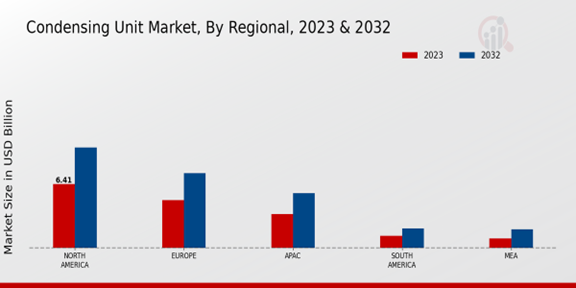Market Growth Projections
The Global Condensing Unit Market Industry is poised for substantial growth, with projections indicating a market value of 17.7 USD Billion in 2024 and an anticipated increase to 30.5 USD Billion by 2035. This growth trajectory suggests a robust demand for condensing units across various applications, driven by factors such as energy efficiency, technological advancements, and regulatory support. The expected CAGR of 5.04% from 2025 to 2035 further underscores the industry's potential for expansion. These projections highlight the importance of strategic investments and innovations in the condensing unit sector to capitalize on emerging opportunities.
Rising Demand for Energy Efficiency
The Global Condensing Unit Market Industry is experiencing a notable surge in demand for energy-efficient solutions. As energy costs continue to rise, consumers and businesses are increasingly seeking systems that minimize energy consumption while maximizing performance. This trend is reflected in the projected market growth, with the industry expected to reach 17.7 USD Billion in 2024. Manufacturers are responding by developing advanced condensing units that utilize innovative technologies, such as variable speed compressors and eco-friendly refrigerants, which not only reduce energy usage but also comply with stringent environmental regulations.
Increasing Focus on Sustainable Practices
The Global Condensing Unit Market Industry is witnessing a growing emphasis on sustainability across various sectors. Businesses are increasingly adopting sustainable practices to reduce their carbon footprint and enhance their corporate social responsibility. This shift is driving the demand for condensing units that are designed with eco-friendly materials and energy-efficient technologies. As companies strive to meet sustainability goals, the market is likely to expand, with a projected CAGR of 5.04% from 2025 to 2035. This focus on sustainability not only benefits the environment but also aligns with consumer preferences for greener products.
Technological Advancements in Condensing Units
Technological innovation plays a pivotal role in shaping the Global Condensing Unit Market Industry. The introduction of smart condensing units equipped with IoT capabilities allows for real-time monitoring and optimization of performance. These advancements not only enhance operational efficiency but also provide users with valuable data for predictive maintenance. As the industry evolves, manufacturers are likely to invest in research and development to create more sophisticated systems that cater to the growing demand for automation and connectivity. This trend is expected to drive market growth, as businesses increasingly prioritize technology-driven solutions.
Growth in Refrigeration and Air Conditioning Sectors
The Global Condensing Unit Market Industry is significantly influenced by the expansion of the refrigeration and air conditioning sectors. As urbanization accelerates globally, the demand for efficient cooling solutions in residential, commercial, and industrial applications is on the rise. This growth is projected to contribute to the market's expansion, with an anticipated value of 30.5 USD Billion by 2035. The increasing adoption of condensing units in supermarkets, cold storage facilities, and HVAC systems underscores the importance of this driver, as businesses seek reliable and efficient cooling technologies to meet consumer needs.
Regulatory Support for Environmentally Friendly Solutions
The Global Condensing Unit Market Industry is benefiting from regulatory frameworks that promote environmentally friendly refrigeration solutions. Governments worldwide are implementing stringent regulations aimed at reducing greenhouse gas emissions and encouraging the use of low-GWP refrigerants. This regulatory support is driving manufacturers to innovate and develop condensing units that align with these environmental goals. As a result, the market is likely to witness a shift towards more sustainable products, which could enhance competitiveness and appeal to environmentally conscious consumers. This trend is expected to contribute to the overall growth of the industry.















